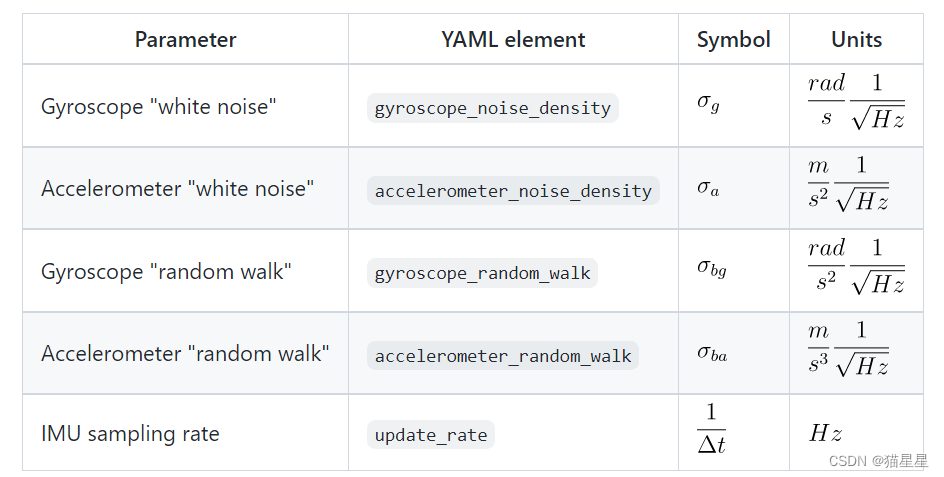imu内参标定
提示:本文部分大部分内容都是通过多次实验测试总结得出,有些地方比较玄学,也不是很严谨,希望懂得的小伙伴能在评论区指出。
前言
先把结论放在这里,关于imu噪声参数的标定对于vio(比如vins、orb3)其实并没有多重要,虽然说他们的配置文件中都要求给一个imu的噪声参数,理由会在正文中说明。如果做imu的标定只是为了给vio的配置文件中imu的噪声参数一个数值的话,不必花太多时间追求一个精确的imu噪声参数,耗时且意义不大。
1.imu噪声模型介绍
详细的imu的噪声模型的介绍可以参考kalibr文档的介绍,但是感觉解释的不是很清晰,推荐看下An introduction to inertial navigation加深下理解,我自己也做了一个关于imu噪声模型的总结。
这里仅展示几个要注意的地方:
- imu的噪声分为两种,“White Noise”和“Bias”,都有连续时间模型和连续时间模型两种形式,两种模式可以相互转换,这里强调一下有的标定工具输出的是连续型(imu_utils),有的是离散型(kalibr_allan)。另外有的VIO算法需要的是连续性的imu噪声参数,有的是连续型的噪声参数,具体根据代码或单位辨识。
- 为了方便后续的imu-cam外餐标定,有必要说一下Kalibr需要的imu噪声参数的格式。Kalibr需要的噪声参数都是连续时间模型的,单位如下图:

2./imu/data和/imu/data_raw的区别
px4的imu有两个消息,一个是/mavros/imu/data,一个是/mavros/imu/data_raw。在mavros wiki中解释说data是求解了姿态的,而data_raw是原始数据。一般来说大部分的imu传感器都是有data和data_raw两个消息的,但是vio中比较倾向与用谁并不知道,或者说用谁都差不多,这个问题有没有评论区能解答的。
我自己录制了zed2相机的imu和px4的imu在静止状态下的数据,记录在下图:
- 上图中上部分是px4的imu的陀螺仪测的角速度消息,可以看出其实data相比data_raw噪声要更小,所以px4的/imu/data是进过一个滤波处理的。
- 下方是zed2的imu消息,data和data_raw基本差不多,但是仔细看还是有一些差别的,可以认为data是有一个基本的去噪处理的吧。
3. px4飞控imu标定,以及遇到的问题
补充:px4的内置有两个imu,选择imu数据的时候也是采用投票机制,具体可以参考下面的链接。关于能否用带有冗余imu机制的传感器作为vio中imu的数据来源,作者本来持怀疑态度,但是从论文中来看,px4很少出现,vins-mono用的大疆的N3飞控(没有imu冗余设计),但是《Robust Real-time LiDAR-inertial Initialization》这篇文章用的是px4-mini(有冗余的imu设计,和px4一样)作为lio的imu数据源。
px4传感器冗余机制的介绍
一些有一些博客使用仿真的imu数据对kalibr_allan和imu_utils标定的结果进行了比较(链接),结果是kalibr_allan的高斯白噪声和随机游走都比较准,而imu_util(gaowenliang的版本)的随机游走误差的标定比较差,所以推荐使用kalibr_allan。但是这位博主用的是仿真的数据,和实际情况或许有一些偏差,我自己使用kalibr_allan的过程中并没有取得较为理想的效果,并不推荐kalibr_allan(虽然是uzh大神们写的),更推荐mintar修改后的imu_utils。
kalibr_allan标定imu内参
kalib_allan里面有个把bag文件转换为mat文件的ros节点,需要在ubuntu下安装matlab,安装完后还需要让cmake能找到matlab,可以参考这个https://blog.csdn.net/wuzuyu365/article/details/52330830
下文我就使用/mavros/imu/data进行imu内参的标定。
- 第一步是录制imu静止状态的数据。
- bag转mat
roseun bagconvert bagconvert "bag文件位置" “imu的topic”会在bag文件的目录位置生成一个对应的mat文件,如果topic没对,会生成一个大概177bytes的错误文件。 - 运行matlab脚本生成allan方差的分析图片,需要修改m文件里的mat文件的目录位置和imu频率,图片会生成在data文件夹下。
 问题: 我之前录了2h的数据,结果会出现部分参数为Nan的情况(如上图,主要就是陀螺仪的随机游走),但是我录制了4个小时发现还是NAN,接着尝试了10h,也是类似的情况,在录制12小时的数据才勉强得出数据,但是Allan图的形状并不是很标准的感觉,和12小时数据得到的Allan图和上图图其实长的比较像,并没有明显的0.5斜率的直线可以拟合得到陀螺仪的随机游走噪声。
问题: 我之前录了2h的数据,结果会出现部分参数为Nan的情况(如上图,主要就是陀螺仪的随机游走),但是我录制了4个小时发现还是NAN,接着尝试了10h,也是类似的情况,在录制12小时的数据才勉强得出数据,但是Allan图的形状并不是很标准的感觉,和12小时数据得到的Allan图和上图图其实长的比较像,并没有明显的0.5斜率的直线可以拟合得到陀螺仪的随机游走噪声。
4.使用mintar修改的imu_utils进行zed2相机imu的标定
说明:
gaowenliang的imu_utils貌似有单位的问题,然而大神已经很久没出现了,在github的issue有关于单位问题的讨论,然后有个叫mintar的大佬把单位问题修改了,把输出的值都改成了连续时间的单位,也开源了,并且使用realsense相机同allan_variance_ros的标定结果做了对比(这个开源算法也是Kalibr推荐的,对比结果在imu_utils的issue里),并且结果很相近,所以算法应该是比较合理正确的。
下文使用mintar版本的imu_utils对zed2相机里的imu做了一个标定。
两个版本的使用方法都一样,不再介绍,本文录制了4小时的静止imu的数据(其实算法里只用了两个小时的数据),然后标定的结果在下面(data和data_raw我都标定了,不知道vio应该用哪个):
zed2_imu_dataacc_nacc_wgyro_ngyro_w/imu/data0.0009723914986221080.00001618161369788250.0001120594344447880.0000000377973509488189/imu/data_raw0.0009724721493928010.00001619757247543750.0001039034780287490.00000000748263828361598
这个图是用imu_utils的matlab代码画的/imu/data的数据,红线是gyro的数据,蓝线是acc的数据,实线应该是拟合的数据(从这个角度看,其实kalibr_allan应该是没有拟合曲线来读取参数,所以读不出来,没研究过源码,这些都是猜的)?圈和×是真实数据画出来的。
讨论
标定时录制的数据集都是在imu静止的状态下录制的,但是我们在做imu-cam标定或者是vio的时候,imu都是处于动态运动的状态,所以直接使用我们标定的参数是会出问题的,大概率会导致系统的奔溃,这个问题在这个github issue中有讨论,mintar给了几点假设:
- The allan variance estimation methods (mintar/imu_utils and ori-drs/allan_variance_ros) estimate a model based on Q, N, B, K, R or at least N (“rate/acceleration white noise”), B (“bias instability”), K (“rate/acceleration random walk”). But all VIO packages and Kalibr just use N and K.
- The calibration is done under close to ideal circumstances in a static setup. In a dynamic setting, with other factors like temperature changes etc., the noise will be higher.
- The calibration packages take the average of the axes, but some IMUs have different gyros/accelerometers for different axes, so one should probably use the maximum and not the average to be on the safe side.
- In my setup, there’s no hardware synchronization between IMU and camera. Maybe using a higher standard deviation for the IMU prevents VINS from trusting the IMU too much and deviating when the real error is from a wrong time synchronization.
另外,在Kalibr的imu noise model的介绍的最后也做了一个说明:
It is important to note that the IMU measurement error model used here is derived from a sensor which does not undergo motion, and at constant temperature. Hence scale factor errors and bias variation caused by temperature changes, for example, are not accounted for. So clearly, the model is optimistic. Particularly when using low-cost MEMS IMUs with Kalibr, you may have to increase the noise model parameters to “capture” these errors as well. In other words, if you use directly the “sigmas” obtained from static sensor data, Kalibr will tend to trust your IMU measurements too much, and its solution will not be optimal.
From our experience, for lowest-cost sensors, increasing the noise model parameters by a factor of 10 or more may be necessary. If you use Kalibr with such a device, please give us feedback, such that we can develop specific guidelines, device-specific parameter suggestions, or more advanced methods to determine these parameters.
那么从这个讨论的内容来看,我们标定imu的结果其实不能直接用在vio算法中,最多只能做一个参考吧,在这个基础上做一些放大。也就是说其实我们不做imu的标定也无所谓,对于vio而言,当vio效果不理想的时候可以直接放大一下imu的噪声参数进行比较。包括在imu-cam的标定过程中,imu的噪声参数也不能直接用imu静态状态下标定的结果。
在github issue中有人这样解释,我觉得也很合理:
One additional factor—related to what was mentioned about calibrating in static vs running in dynamic conditions—might be that the IMU model used in all these VO / SLAM algorithms is practical, but still simplistic. I.e. it simply doesn’t model many of the effects on the physical device. I’m thinking of temperature-dependent bias, cross-axis sensitivity, etc. All this means that the errors in your model aren’t actually independent and bias-free and one way to deal with it is by increasing the measurement uncertainty to “mask” out the un-modelled behaviour.
But yes, it’s a valid question what’s the point of calibrating the IMU when you just hand-tune the values anyway. I think hand-tuning will always be needed. Calibration can still inform you about the relative quality of different IMUs and thus help when tuning the parameters (e.g. tell you if your values for a new IMU should be higher or lower than for some reference IMU that you know works well).
下一篇文章:使用Kalibr进行imu-cam的联合标定。
版权归原作者 猫星星 所有, 如有侵权,请联系我们删除。